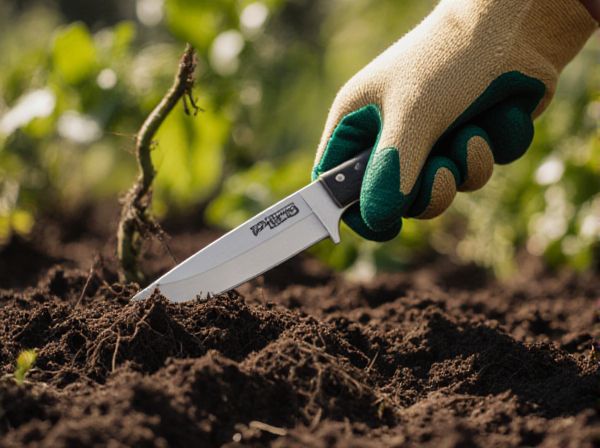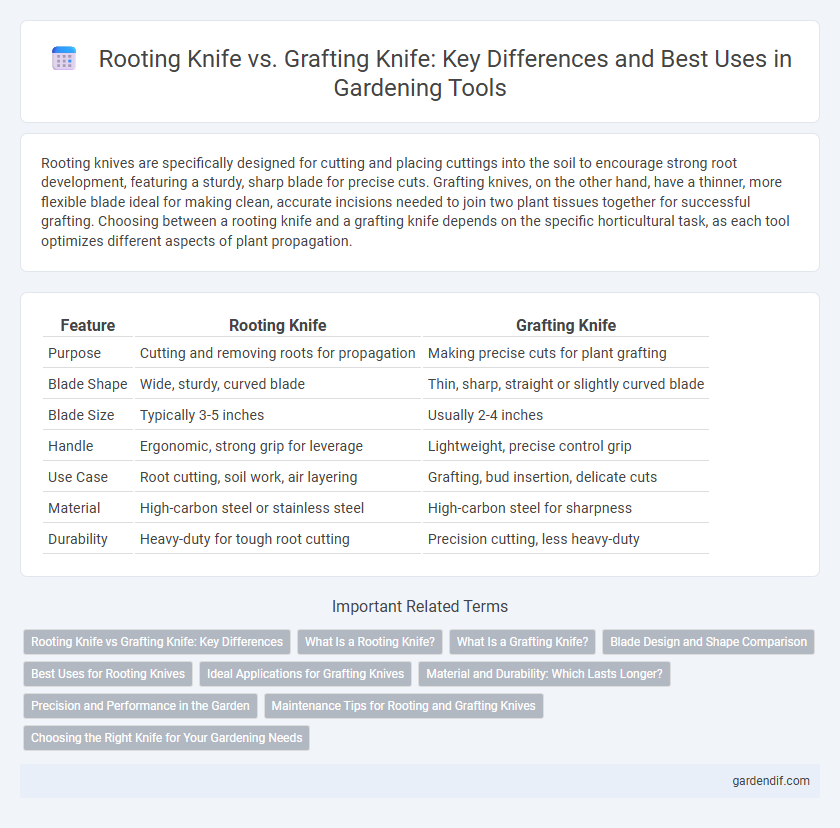
Rooting Knife vs Grafting Knife Illustration
Rooting knives are specifically designed for cutting and placing cuttings into the soil to encourage strong root development, featuring a sturdy, sharp blade for precise cuts. Grafting knives, on the other hand, have a thinner, more flexible blade ideal for making clean, accurate incisions needed to join two plant tissues together for successful grafting. Choosing between a rooting knife and a grafting knife depends on the specific horticultural task, as each tool optimizes different aspects of plant propagation.
Table of Comparison
| Feature | Rooting Knife | Grafting Knife |
|---|---|---|
| Purpose | Cutting and removing roots for propagation | Making precise cuts for plant grafting |
| Blade Shape | Wide, sturdy, curved blade | Thin, sharp, straight or slightly curved blade |
| Blade Size | Typically 3-5 inches | Usually 2-4 inches |
| Handle | Ergonomic, strong grip for leverage | Lightweight, precise control grip |
| Use Case | Root cutting, soil work, air layering | Grafting, bud insertion, delicate cuts |
| Material | High-carbon steel or stainless steel | High-carbon steel for sharpness |
| Durability | Heavy-duty for tough root cutting | Precision cutting, less heavy-duty |
Rooting Knife vs Grafting Knife: Key Differences
Rooting knives are designed with a robust, curved blade ideal for cutting through tough roots and soil, whereas grafting knives feature a slender, sharp blade optimized for making precise incisions on plant stems during grafting. Rooting knives prioritize durability and strength to handle underground work, while grafting knives emphasize accuracy and clean cuts to ensure successful graft unions. The choice between rooting knife and grafting knife depends on the specific gardening task, with rooting knives suited for propagation by root division and grafting knives essential for plant hybridization.
What Is a Rooting Knife?
A rooting knife is a specialized gardening tool designed with a sharp, sturdy blade used for digging out roots and cutting through tough soil or plant material. It typically features a curved blade that allows precise control when removing unwanted roots or preparing plants for transplantation. Rooting knives are essential for tasks requiring careful root manipulation to avoid damaging surrounding plants.
What Is a Grafting Knife?
A grafting knife is a specialized horticultural tool designed for precision cutting during plant grafting, featuring a sharp, thin blade that allows for smooth, clean cuts essential for successful graft unions. Unlike rooting knives, which are primarily used for dividing plants or removing roots, grafting knives facilitate the delicate process of joining two plant tissues to encourage growth and propagation. The design often includes a narrow blade that minimizes damage to the cambium layer, ensuring optimal compatibility between rootstock and scion.
Blade Design and Shape Comparison
Rooting knives feature a robust, wide blade with a straight or slightly curved edge designed to cut through tough roots and soil efficiently, providing durability and leverage. Grafting knives have a finer, sharper, and narrower blade with a precise, curved tip optimized for making clean, intricate cuts on plant stems during grafting. The blade shape of rooting knives emphasizes strength and stability, while grafting knives prioritize precision and control.
Best Uses for Rooting Knives
Rooting knives excel in cutting through tough, fibrous roots and soil for plant propagation and transplanting tasks, making them essential for gardeners and horticulturists who frequently work with rootstocks. Their sturdy, pointed blades provide precision and durability when separating plants or digging out roots without damaging delicate stems. Ideal for propagation methods that require root manipulation, rooting knives offer superior control compared to grafting knives, which are primarily designed for smooth, precise cuts on plant stems and branches.
Ideal Applications for Grafting Knives
Grafting knives are specifically designed for precise cutting needed in horticultural grafting, including making clean, angled incisions that promote successful tissue fusion between rootstock and scion. Their sharp, thin blades enable careful manipulation of delicate plant tissues, making them ideal for fruit tree propagation, bonsai grafting, and other specialized plant breeding tasks. Unlike rooting knives, grafting knives prioritize accuracy and finesse over durability and toughness, ensuring higher success rates in graft union development.
Material and Durability: Which Lasts Longer?
Rooting knives typically feature stainless steel blades designed for corrosion resistance and durability in moist soil conditions, whereas grafting knives often use high-carbon steel to maintain a sharper edge for precise cuts. In terms of longevity, high-carbon steel grafting knives tend to last longer when properly maintained despite being more prone to rust if not cared for. The choice between these tools depends on the balance between corrosion resistance and edge retention needed for specific gardening tasks.
Precision and Performance in the Garden
Rooting knives offer superior precision for cutting small roots and delicate plant material, enhancing performance during propagation tasks. Grafting knives are designed with sharper, thinner blades for clean, accurate cuts essential in grafting to ensure proper plant tissue alignment. Choosing between these tools depends on the garden task, with rooting knives excelling in root handling and grafting knives optimizing graft unions.
Maintenance Tips for Rooting and Grafting Knives
Proper maintenance of rooting and grafting knives ensures sharpness and longevity, essential for precise cuts in plant propagation. Regularly clean blades with rubbing alcohol to prevent sap buildup and rust, then dry thoroughly to avoid corrosion. Sharpen using a whetstone or fine file, and store knives in a dry, protective sheath to maintain blade integrity.
Choosing the Right Knife for Your Gardening Needs
Selecting the right gardening knife depends on your specific horticultural tasks; a rooting knife is ideal for digging, loosening soil, and transplanting seedlings due to its sturdy, pointed blade, while a grafting knife offers precision cutting for joining plant tissues with its thin, sharp, and curved edge. Rooting knives are typically robust and designed for durability in tougher soil conditions, whereas grafting knives facilitate clean cuts essential for successful grafting and budding. Understanding the unique design and purpose of each knife ensures enhanced efficiency and plant health in your gardening projects.
Rooting Knife vs Grafting Knife Infographic

 gardendif.com
gardendif.com